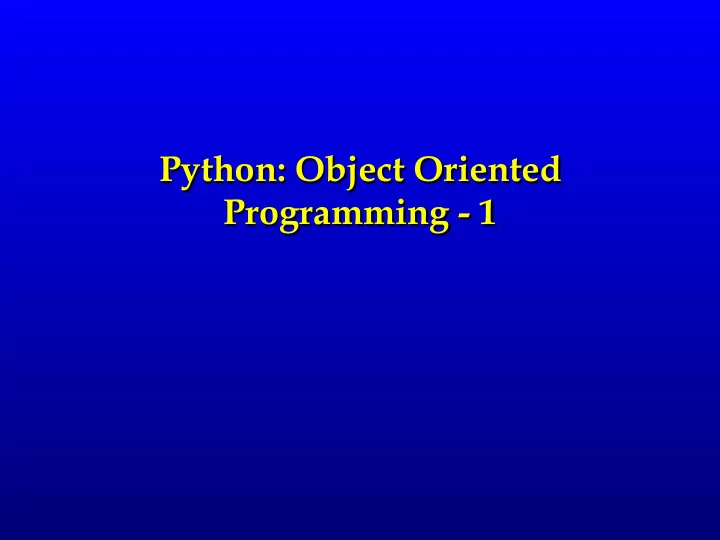

Python: Object Oriented Programming - 1
Objects • Python supports different type of data – 125 (int), 24.04 (float), “Hello” (string) – [3,7,8,10] (list) – {“India”:”New Delhi”, “Japan”:”Tokyo”} • Each of above is an object • Every object has a type, internal data representation and procedures for interaction. • An object is an instance – 125 is an instance of int, Hello is an instance of string
Objects • In Pyhton everything is an object • Can create an object • Can manipulate objects • Can destroy objects explicitly using del or just “forget” about them python system will reclaim destroyed or inaccessible objects –called “garbage collection”
Objects • objects are a data abstraction that capture: (1) an internal representation - through data attributes (2) an interface for interacting with object - through methods (procedures/functions) - defines behaviors but hides implementation
Example: List • lists are internally represented as linked list • [1,2,3,4]: internal representation should be private • manipulation of lists – L[i], L[i:j], + – len(), min(), max(), del(L[i]) – L.append(), L.extend(), L.remove(), L.reverse()…
Classes • Classes make it easy to reuse code • There is a distinction between creating a class and using an instance of the class • creating the class involves defining the class name defining class attributes for example, someone wrote code to implement a list class
Classes
Classes • defining a class involves class Coordinate (object): definition name of parent of class class class # define attributes here • use a special method __init__ to initialize some data attributes
Classes • defining a class involves class Coordinate (object): def __init__(self, x, y): self.x = x self.y = y • creating an instance – c = Coordinate(3,4) – origin=Coordinate(0,0)
Classes: Methods
Classes: Methods
Classes: Methods Equivalent
Classes: Methods • defining your own print method class Coordinate (object): def __init__(self, x, y): self.x = x self.y = y def __str__(self): return “<“+str(self.x)+”,”+str(self.y)+”>” c=Coordinate(3,4) print(c) à <3,4>
Example: Fraction
Example: Fraction • fraction (rational number) class Fraction (object): def __init__(self, n, d): self.num = n self.denom = d def __str__(self): return str(self.num)+”/”+str(self.denom)
Example: Fraction • fraction (rational number) add two rational numbers: def __add__(self, other): num = self.num*other.denom + self.denom*other.num denom = self.denom*other.denom return Fraction(num, denom)
Example: Fraction • fraction (rational number) subtract two rational numbers: def __subtract__(self, other): num = self.num*other.denom - self.denom*other.num denom = self.denom*other.denom return Fraction(num, denom)
Example: Fraction • fraction (rational number) multiply two rational numbers: def multiply(self, other): num = self.num*other.num denom = self.denom*other.denom return Fraction(num, denom)
Example: Fraction • fraction (rational number) divide two rational numbers: def divide(self, other): num = self.num*other.denom denom = self.denom*other.num return Fraction(num, denom)
Example: Fraction • fraction (rational number) def __float__(self): return self.num/self.denom def inverse(self): return self.denom/self.num def reduce(self): ….
Recommend
More recommend